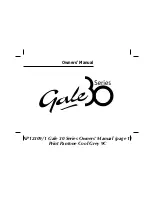
SHUTS OFF:
Check the
GREEN LED
to see if it is lit. If the
GREEN LED
is off check for power,
ground and remote turn on to amp. Also check the internal fuse(s). This amplifier is equipped with
a thermal shutdown system; in the unlikely event of excessive temperatures due to high ambient
or operating temperatures the
YELLOW LED
(Thermal) will light and the amp will shut down for a
short period. The thermal circuit will
auto reset,
cycling the amplifier off and on is not needed to
re-start amp. The amp also has a short circuit and over current protection system. Improper
speaker impedance, wiring shorts or damaged speakers may cause the
RED LED
(Protection) to
trigger shutting the amp down until the problem is corrected and the amp restarted. The amplifier
will actually have to be shut down and restarted to unlock the Protection circuit. Check all the
Status LEDS to help diagnose the situation. To avoid damage to the speakers, turn the volume to
a minimum while waiting for the amp to turn itself back on.
NOISE SUPPRESSION
The vehicle's battery forms a huge capacitor bank that does a fantastic job of filtering noise.
Unfortunately, batteries grow old and lose their ability to hold a charge. At the same time, they
lose their ability to filter noise; even corrosion on the battery terminals will cause increased noise
as it isolates the battery.
If the vehicle is in need of ignition repair or tune up, increased noise will result. Specifically, on
older model vehicles, check the condition of points and condenser, as well as the spark plug
leads. Don't forget to check for resistor plugs too.
TROUBLESHOOTING NOISE
Once the type of noise has been determined, the entry method must be isolated. The easiest
place to start is the amplifier. Unplug the RCA jacks with the
amplifier off
and install RCA
dummy loads (
see
RCA GROUND
section on page 4
). After turning amp back on, listen for a
change in the noise level. If little or no change occurs, the amplifier's input power source
(battery/alternator) is contaminated or you have bad chassis ground connections to amplifier. If
the noise is gone, the possibilities are: a ground loop between the radio and some other piece of
equipment inline or between the amplifier(s), no RCA ground getting to amp, or a noise problem
earlier in the system. If the problem is a ground loop, the best solution is to check grounding on
all equipment inline and/or a better ground for the amp(s). If one side of the speaker wires has
made partial or full contact to the metal of the vehicle or speaker frame, this also will cause a
ground loop, and might also cause a squeal thru the speaker or system. It can also back-feed and
cause the amplifier to run warmer than usual or possibly go into protection.
The next check is for radiated noise. With the deck still electrically connected to the vehicle,
slowly remove it from its installation, and listen for a change in noise level. Any reduction would
indicate that noise was being radiated directly into the deck while it was in the dash. If you are
dealing with radiated noise, the only solution is isolation. The easiest method is usually to move
the contaminated wiring away from the stereo's wiring.
The best way to eliminate power line noise is to install a filter capacitor across the noise source.
The best capacitors to use are .5mfd 25v bypass capacitors for the coil, as well as any accessory
In vehicles today there are all types of advanced electronics built into the vehicle or added to the
vehicle by the owner that can cause interference. It is even more important to pay attention to
where you run your wiring and signal cables so they do not pick up noise from these other
electronics. It is important to use any noise inductors that an aftermarket radio manufacturer may
provide for USB, iPod, iPhone or other cables on their radios. These cables act as antennas and
can cause noise to enter the stereo system. The line inductors that some radio manufacturers
8
Summary of Contents for LP Series TO-3P
Page 10: ...10 ...




























